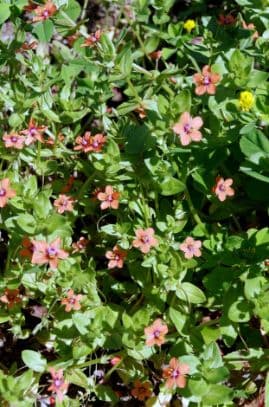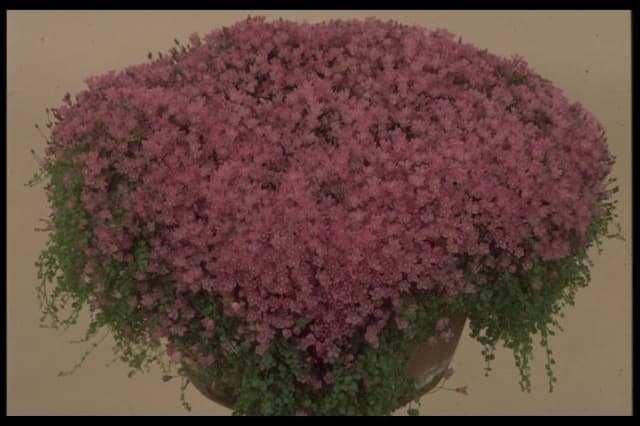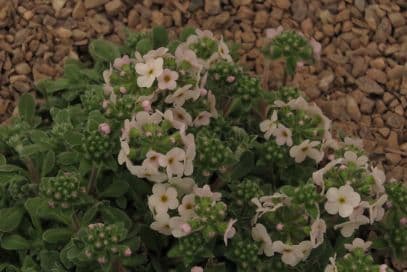Pink Rock Jasmine Androsace carnea subsp. laggeri

ABOUT
Androsace carnea subsp. laggeri, commonly known as Pink Rock Jasmine, is a charming perennial plant admired for its showy floral display. The plant forms a low-growing rosette of leaves from which emerge flower stalks topped with clusters of delicate pink flowers. Each blossom features a small, cup-shaped appearance with deeper pink shades at the center, creating a delightful gradient of color. The leaves are typically lush green and may have a slightly furry or hairy texture, forming a compact mat that serves as a backdrop to the floral spectacle above. The Pink Rock Jasmine blooms in the warmer months, and its blossoms are a favorite among gardeners and pollinators alike for their vibrant hue and appealing form. With a preference for rocky or alpine habitats, it is often found decorating crevices and ledges with its ornamental beauty.
About this plant
 Names
NamesFamily
Primulaceae
Synonyms
Pink Rock Jasmine, Laggers' Androsace
Common names
Androsace helvetica (Heer) R. Knuth, Androsace pubescens Derganc
 Toxicity
ToxicityTo humans
Androsace carnea subsp. laggeri, commonly referred to as Rock Jasmine, is not widely known to be toxic to humans. There is limited information available on its potential toxicity, which suggests that if it were poisonous, it is not commonly recognized as such. Therefore, the symptoms of poisoning, if any, are not well-documented. As with any plant, it is always advisable to exercise caution and avoid ingesting any part of a plant unless it is known to be edible.
To pets
Similar to the information available for humans, Rock Jasmine is not widely recognized as a toxic plant to pets. There is limited data on the plant’s toxicity, meaning that it either does not contain significant levels of toxic substances or it is not commonly encountered as a problem for animals. Without specific reports or studies on its toxicity to pets, it is not possible to provide details on symptoms or consequences of ingestion. However, as a precautionary measure, it is best to prevent pets from consuming any part of plants that are not known to be safe.
 Characteristics
CharacteristicsLife cycle
Perennials
Foliage type
Evergreen
Color of leaves
Green
Flower color
Pink
Height
0.5 feet (15 centimeters)
Spread
0.5 feet (15 centimeters)
Plant type
Herb
Hardiness zones
5
Native area
Europe
Benefits
 General Benefits
General Benefits- Ecological support - Androsace carnea subsp. laggeri contributes to local ecosystems by providing food and habitat for various insects and small animals.
- Biodiversity enhancement - By growing this plant species, you can help to maintain and enhance biodiversity within its native range, which is crucial for healthy ecosystems.
- Aesthetic appeal - Androsace carnea, commonly known as Alpine Rock Jasmine, adds visual interest to gardens and natural landscapes with its attractive pink or red flowers.
- Soil stabilization - The plant's roots can help prevent soil erosion in rocky alpine environments, which is especially important for maintaining mountainous landscapes.
- Pollinator support - Alpine Rock Jasmine provides nectar and pollen to bees and other pollinating insects, which are essential for the reproduction of many plants and crops.
- Educational interest - Studying native alpine plants like Androsace carnea subsp. laggeri can offer educational opportunities in botany, ecology, and conservation.
- Conservation value - Conserving native species like Androsace carnea subsp. laggeri can be part of broader conservation efforts focused on protecting alpine habitats from environmental threats.
 Medical Properties
Medical PropertiesThis plant is not used for medical purposes.
 Air-purifying Qualities
Air-purifying QualitiesThis plant is not specifically known for air purifying qualities.
 Other Uses
Other Uses- Alpine rock gardens: Androsace carnea is an excellent addition to alpine rock gardens due to its compact growth habit and attractive foliage.
- Container gardening: This plant can be grown in containers, hanging baskets, or window boxes to enhance small spaces with its delicate flowers.
- Groundcover: Given its low-growing nature, Androsace carnea can serve as a beautiful groundcover, filling spaces between stones or pavers.
- Themed gardens: It can be included in fairy or miniature gardens as it adds a sense of whimsy with its small, bright flowers.
- Butterfly gardens: The bright flowers of Androsace carnea attract butterflies and other pollinators, enhancing biodiversity in the garden.
- Photography: The vibrant flowers and interesting growth pattern make it a great subject for macro photography enthusiasts.
- Education: Can be used in educational settings to teach children about alpine plants and their adaptations to harsh growing conditions.
- Green roofing: In suitable climates, it can be utilized in green roof projects to add color and diversity.
- Seasonal arrangements: The flowers can be used in small-scale, fresh floral arrangements or as part of living table centerpieces.
- Conservation: Planting Androsace carnea can contribute to the conservation of alpine species, especially in areas where native flora is threatened.
Interesting Facts
 Feng Shui
Feng ShuiThe Androsace plant is not used in Feng Shui practice.
 Zodiac Sign Compitability
Zodiac Sign CompitabilityThe Androsace plant is not used in astrology practice.
 Plant Symbolism
Plant Symbolism- Endurance: Androsace carnea, commonly known as Pink Rock Jasmine, often grows in high alpine habitats, symbolizing the ability to thrive in challenging conditions and endure hardships.
- Purity: The delicate, pale pink flowers of Pink Rock Jasmine may represent innocence and purity.
- Daintiness: The small and delicate nature of the plant's blossoms can symbolize daintiness and fine beauty.
- Adaptability: As a plant that can adapt to harsh alpine environments, Pink Rock Jasmine may symbolize flexibility and the ability to adjust to various circumstances in life.
 Water
WaterRock Jasmine should be watered moderately, allowing the soil to dry out slightly between watering intervals to prevent root rot. Typically, water once a week with about 8 ounces of water, but adjust frequency depending on the humidity, temperature, and light conditions. During the active growth season in spring and summer, maintain consistent watering, but reduce the amount in fall and winter when the plant's growth slows down. Always use room-temperature water and avoid wetting the foliage to prevent fungal diseases.
 Light
LightRock Jasmine thrives in bright, indirect light with some direct morning sun. The ideal spot for this plant would be east-facing windows where it can bask in the gentle morning light but is shielded from the harsh afternoon sun. Avoid placing it in full shade or excessively strong direct sunlight, which can harm the foliage and affect flowering.
 Temperature
TemperatureRock Jasmine prefers cool to moderate temperatures and can survive minimum temperatures down to approximately 20°F but performs best within the 50°F to 70°F range. Avoid exposing the plant to temperatures above 80°F, as overheating can stress the plant and hinder growth. This alpine species is fairly cold-hardy and can tolerate chilly conditions better than extreme heat.
 Pruning
PruningPruning Rock Jasmine is typically done to remove dead or spent flowers and to shape the plant if necessary. Light pruning can be performed after the flowering season in late spring or early summer to encourage denser growth and more blooms for the following year. Regularly deadhead spent blooms to promote continuous flowering.
 Cleaning
CleaningAs needed
 Soil
SoilRock Jasmine thrives in a well-draining soil mix with a pH ranging from 5.5 to 7.5. A mixture composed of equal parts loam, sand, and peat moss or a fine gravel is ideal, as it provides the right balance of moisture retention and drainage.
 Repotting
RepottingRock Jasmine should be repotted every 2-3 years to refresh the soil and accommodate root growth. It's important not to disturb the roots more than necessary during repotting.
 Humidity & Misting
Humidity & MistingRock Jasmine prefers moderate to high humidity levels, around 50-70%. This alpine plant tolerates a range of humidity conditions as long as the soil drainage is adequate.
 Suitable locations
Suitable locationsIndoor
Provide bright light, cool temps.
Outdoor
Place in partial sun, protect from intense heat.
Hardiness zone
4-8 USDA
 Life cycle
Life cycleAndrosace carnea subsp. laggeri, more commonly known as Pink Rock Jasmine, begins its life as a seed, which after experiencing conditions favorable for germination, typically in spring, sprouts and develops a small root system and shoots. The seedling stage involves the growth of these shoots into small, rosette-forming leaves close to the ground, allowing the plant to endure alpine conditions. As the plant matures, it enters the vegetative stage where it grows larger and produces more leaves, preparing for reproduction. During the flowering stage, typically in late spring to early summer, Pink Rock Jasmine produces clusters of pink or white flowers that attract pollinators for sexual reproduction. After successful pollination, the flowers develop into capsule-like fruits that release seeds when mature, ensuring the next generation of plants. In harsh alpine environments, the plant may enter a period of dormancy during the colder months to conserve resources, completing its life cycle when it regrows the following spring.
 Propogation
PropogationPropogation time
Spring-summer
The popular method of propagation for the Androsace carnea subsp. laggeri, commonly known as the Pink Rock Jasmine, is through seed sowing. Seeds can be sown in pots or trays filled with a well-draining soil mix, ideally at the beginning of spring. The seeds should be lightly covered with soil and kept moist but not waterlogged. Providing a temperature of around 70°F (21°C) will aid in germination, which typically occurs within a few weeks. After the seedlings have developed their first set of true leaves, they can be carefully transplanted into individual pots and grown on, with care to not disturb the roots too much during the process.









